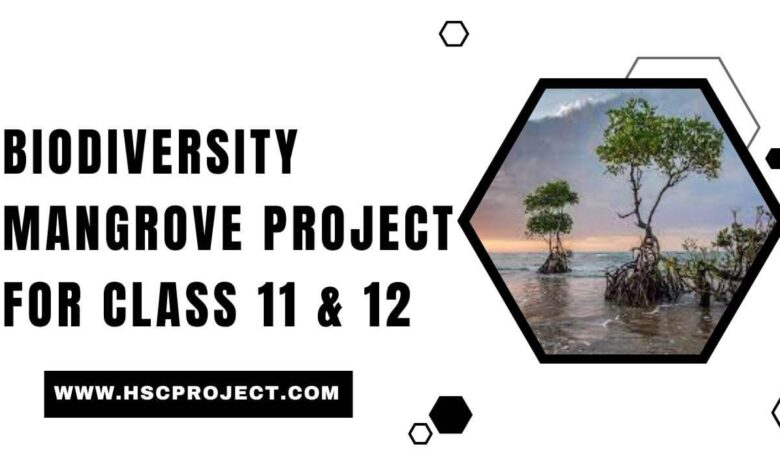
Biodiversity mangrove project for class 11 and 12
Acknowledgement:
I would like to express my sincere gratitude to all those who have supported and contributed to the successful completion of this “Biodiversity Mangrove Project” for my class 11/12. Without their invaluable assistance, this project would not have been possible.
First and foremost, I extend my heartfelt thanks to my subject teacher, [Teacher’s Name], for suggesting and guiding me throughout this project. Your expertise and encouragement were instrumental in shaping the direction of this work.
I am also thankful to my parents/guardians for their unwavering support and understanding during the project’s research and preparation phases. Your constant motivation and belief in my abilities inspired me to persevere.
Furthermore, I am indebted to the local conservationists and experts who graciously shared their knowledge and insights about mangroves and biodiversity. Their inputs were invaluable in adding depth and accuracy to this project.
I would like to extend my appreciation to the staff and volunteers of the [Name of Conservation Organization] for their efforts in protecting and preserving mangrove ecosystems. Your dedication to environmental conservation serves as an inspiration to us all.
I must also acknowledge the assistance provided by the various libraries, online databases, and academic journals that allowed me access to a vast repository of relevant information.
Lastly, I want to thank my friends for their moral support and encouragement throughout the journey of completing this project.
This project has provided me with a deeper understanding of the importance of mangroves in maintaining biodiversity and the urgent need for their conservation. I hope that my work contributes to raising awareness about the significance of these unique ecosystems and the critical role they play in our environment.
Thank you all once again for your invaluable contributions to this project.
Sincerely,
[Your Name]
Introduction to Mangroves:
Mangroves are fascinating coastal ecosystems that bridge the divide between land and sea, occupying the interface where freshwater rivers and saltwater oceans meet. These unique habitats are home to a diverse array of plant and animal species that have evolved remarkable adaptations to thrive in the challenging conditions of the intertidal zone.
Found in tropical and subtropical regions around the world, mangroves play a vital role in the ecological balance of coastal environments. Their intricate root systems act as natural buffers, providing protection against coastal erosion and storm surges. Additionally, these dense networks of roots offer essential nursery grounds for various marine species, supporting a complex web of life within the mangrove ecosystem.
The biodiversity found within mangroves is awe-inspiring. Mangrove forests are often a haven for a wide range of flora and fauna, including unique species not found in any other type of habitat. These resilient ecosystems are well-adapted to the saline waters they inhabit, with various plant species boasting specialized mechanisms to cope with high salt concentrations and waterlogged soils.
Beyond their ecological significance, mangroves also serve as essential carbon sinks. The dense vegetation absorbs and stores significant amounts of carbon dioxide, helping to mitigate the impacts of climate change.
Unfortunately, despite their ecological importance, mangroves face numerous threats. Human activities such as deforestation for urban development, aquaculture, and logging, as well as pollution and climate change, pose serious risks to the survival of these ecosystems. As a result, many mangrove habitats are rapidly diminishing, putting at risk the rich biodiversity they harbor and the invaluable services they provide to both nature and communities.
To safeguard these vital coastal ecosystems and the numerous benefits they offer, concerted conservation efforts and awareness-raising initiatives are urgently needed. Through the implementation of sustainable management practices and community involvement, we can strive to protect and restore these invaluable ecosystems for the benefit of current and future generations.
In this project, we will delve deeper into the world of mangroves, exploring their biodiversity, ecological importance, the challenges they face, and the conservation efforts in place to preserve these unique and critical coastal ecosystems. Let us embark on this journey to understand, appreciate, and safeguard the wonders of mangroves.
Mangroves

Threats to Mangroves:
Mangroves are facing a multitude of threats that put these critical coastal ecosystems at risk. Despite their ecological importance, many mangrove habitats worldwide are being degraded and lost at alarming rates. The threats to mangroves are often anthropogenic, resulting from human activities that directly or indirectly impact these fragile environments. Some of the key threats to mangroves include:
- Deforestation and Land Conversion: One of the most significant threats to mangroves is deforestation for various purposes, such as urban development, agriculture, aquaculture, and infrastructure projects. The clearing of mangrove forests to make way for human activities disrupts the delicate ecological balance, leading to habitat loss and fragmentation.
- Pollution: Pollution from various sources, including agricultural runoff, industrial discharge, and domestic waste, can contaminate mangrove ecosystems. Pollutants such as pesticides, heavy metals, and plastics can harm mangrove plants, animals, and microorganisms, impacting their health and reproductive success.
- Climate Change: Climate change poses a severe threat to mangroves. Rising sea levels can flood and erode mangrove areas, leading to loss of habitat. Changes in weather patterns and increased frequency and intensity of storms can cause physical damage to mangrove forests. Additionally, climate change disrupts the delicate balance of salt and freshwater, affecting the health and survival of mangrove species.
- Aquaculture and Shrimp Farming: The expansion of aquaculture, particularly shrimp farming, often involves the clearance of mangrove forests to create ponds. This results in the destruction of mangrove habitats, leading to biodiversity loss and negative impacts on local communities that rely on mangroves for their livelihoods.
- Overharvesting and Unsustainable Fishing: Overharvesting of mangrove resources, such as wood, shellfish, and fish, can deplete populations and disrupt ecological interactions within the ecosystem. Unsustainable fishing practices can also lead to the decline of important fish species that rely on mangroves as nursery grounds.
- Invasive Species: Introduction of non-native plant and animal species can disrupt the native biodiversity of mangroves. Invasive species can outcompete native flora and fauna, altering the ecosystem’s structure and functioning.
- Coastal Development: Rapid urbanization and coastal development can lead to the encroachment of human activities into mangrove areas. Dams, roads, and other infrastructure projects can alter water flow, disrupt sediment deposition, and fragment mangrove habitats.
- Illegal Logging and Harvesting: Illegal logging and harvesting of mangroves for wood, fuelwood, or other purposes can exacerbate the pressure on these ecosystems, leading to habitat destruction and degradation.The combined effect of these threats is putting immense pressure on mangroves worldwide. As a result, numerous mangrove habitats have been lost or severely degraded, with consequences for the rich biodiversity they support and the essential ecosystem services they provide, such as shoreline protection, carbon sequestration, and supporting fisheries.Efforts to conserve mangroves must address these threats through a combination of sustainable management practices, community involvement, policy implementation, and international cooperation. Raising awareness about the value of mangroves and the importance of their preservation is crucial to secure the future of these unique and vital coastal ecosystems.

Case Studies:
Let’s explore some case studies of mangrove projects and initiatives that have been successful in conservation and restoration efforts:
- Sundarbans Mangrove Forest, Bangladesh and India:The Sundarbans is one of the largest mangrove forests in the world, spanning the delta region of the Ganges, Brahmaputra, and Meghna rivers. It is shared between Bangladesh and India and is home to a diverse range of wildlife, including the iconic Bengal tiger. The Sundarbans face threats from climate change, illegal logging, and habitat degradation. To address these challenges, both countries have implemented conservation projects and established protected areas. Community-based initiatives, involving local communities in mangrove conservation, have proven effective in preserving these vital ecosystems.
- Mangrove Action Project, Southeast Asia:The Mangrove Action Project (MAP) is a non-profit organization working in various countries across Southeast Asia to protect and restore mangrove ecosystems. MAP focuses on community-based conservation efforts, empowering local communities to become stewards of their mangrove resources. Through education, awareness campaigns, and sustainable livelihood projects, MAP has successfully engaged communities in mangrove restoration and protection, helping to mitigate the impacts of deforestation and aquaculture.
- Mangroves for the Future (MFF), Asia and Africa:Mangroves for the Future is a regional initiative supported by various organizations, including the International Union for Conservation of Nature (IUCN) and the United Nations Development Programme (UNDP). MFF works in 11 countries across Asia and Africa to promote the conservation and sustainable management of mangroves. The initiative emphasizes community involvement, capacity-building, and knowledge-sharing among stakeholders. It has facilitated numerous projects focused on ecosystem restoration, livelihood enhancement, and climate change adaptation.
- Mangrove Restoration in the Philippines:The Philippines has faced significant mangrove loss due to coastal development, aquaculture, and typhoon impacts. In response, local organizations and government agencies have launched mangrove restoration initiatives. For instance, the “Building Mangrove Resilience for Climate Change Adaptation and Disaster Risk Reduction” project has focused on planting mangroves along vulnerable coastlines to protect communities from storm surges and erosion. Community participation, education, and scientific research have been instrumental in the success of these projects.
- Ecosystem-Based Adaptation in Vietnam:In Vietnam, mangrove restoration has been incorporated into climate change adaptation strategies. Projects like the “Mangroves and Markets Project” by the World Wildlife Fund (WWF) have promoted sustainable aquaculture practices that coexist with mangrove conservation. By combining ecological restoration with community-based livelihood development, the initiative aims to improve both the resilience of ecosystems and the well-being of local communities.
Conclusion:
These case studies highlight the importance of community involvement, international collaboration, and integrated approaches in successfully conserving and restoring mangrove ecosystems. By recognizing the value of mangroves for biodiversity conservation, climate change mitigation, and livelihood support, these initiatives offer valuable lessons for the ongoing efforts to protect these critical coastal habitats.
In conclusion, the “Biodiversity Mangrove Project” has provided us with a comprehensive understanding of the significance of mangroves as unique and vital coastal ecosystems. Throughout this exploration, we have gained insight into the rich biodiversity present within mangrove forests, the ecological importance they hold, and the threats they face in today’s rapidly changing world.
Mangroves, with their intricate root systems and diverse flora and fauna, offer a habitat that supports a plethora of plant, animal, and microbial species. These species have evolved remarkable adaptations to thrive in the challenging intertidal zone, making mangroves one of the most diverse and productive ecosystems on Earth.
The ecological importance of mangroves cannot be overstated. They provide invaluable ecosystem services, including shoreline protection against erosion and storm surges, carbon sequestration to mitigate climate change, and acting as essential nursery grounds for numerous marine species that contribute to fisheries.
However, despite their importance, mangroves face a myriad of threats, primarily driven by human activities. Deforestation, pollution, climate change, aquaculture, and coastal development have led to the loss and degradation of mangrove habitats worldwide, putting immense pressure on their rich biodiversity and essential services.
Thankfully, through case studies and examples of successful initiatives, we have seen that conservation and restoration efforts can make a significant difference in preserving mangrove ecosystems. Community-based involvement, sustainable management practices, and international collaboration play crucial roles in safeguarding mangroves for future generations.
As we move forward, it is essential to prioritize the conservation of mangroves and raise awareness about their value and vulnerability. By recognizing their ecological significance and the services they provide, we can foster a sense of stewardship among communities and decision-makers, leading to more effective conservation efforts.
In our pursuit of sustainable development, let us remember that the protection of mangroves is not just a matter of environmental concern but also an issue of social and economic significance. Preserving these coastal ecosystems will not only safeguard biodiversity and ecosystem services but also support the livelihoods of countless communities worldwide.
In conclusion, the “Biodiversity Mangrove Project” has highlighted the importance of protecting these fragile yet resilient ecosystems. By valuing and conserving mangroves, we can work towards a more sustainable and harmonious relationship between human societies and the natural world. Let us stand together in ensuring the survival of mangroves and the myriad of life they support for the benefit of our planet and generations to come.
Certificate of Completion
Certificate of Appreciation
[Your School/Institution Logo]I am thrilled to be presented with this Certificate of Appreciation for successfully completing the “Biodiversity Mangrove Project” for Class 11/12. This project has been an incredible journey, and I am deeply honored to have received recognition for my efforts.
Throughout this project, I delved into the fascinating world of mangroves, learning about their vital role as coastal ecosystems that bridge the divide between land and sea. I explored their rich biodiversity, ecological importance, and the numerous threats they face in our changing world. The project allowed me to understand the significance of mangroves in maintaining biodiversity, providing habitat for various species, and serving as a natural buffer against coastal erosion and storms.
I must express my heartfelt gratitude to my subject teacher, [Teacher’s Name], for guiding and supporting me throughout this endeavor. Their expertise and encouragement played a crucial role in shaping the direction of my work, and I am grateful for their guidance.
I also want to extend my thanks to my parents/guardians for their unwavering support and understanding during the research and preparation phases of this project. Their constant motivation and belief in my abilities inspired me to persevere and do my best.
Moreover, I am indebted to the local conservationists and experts who generously shared their knowledge and insights about mangroves and biodiversity. Their inputs were invaluable in adding depth and accuracy to my project.
I would like to express my appreciation to the staff and volunteers of the [Name of Conservation Organization] for their efforts in protecting and preserving mangrove ecosystems. Their dedication to environmental conservation serves as an inspiration to us all.
I must also acknowledge the assistance provided by various libraries, online databases, and academic journals, which allowed me access to a vast repository of relevant information for my research.
Last but not least, I want to thank my friends for their moral support and encouragement throughout the journey of completing this project. Their words of encouragement and belief in my abilities kept me motivated during challenging times.
This project has provided me with a deeper understanding of the importance of mangroves in maintaining biodiversity and the urgent need for their conservation. I hope that my work contributes to raising awareness about the significance of these unique ecosystems and the critical role they play in our environment.
Receiving this Certificate of Appreciation is truly an honor, and I am grateful to have been given the opportunity to explore and contribute to the field of environmental conservation. I am committed to continuing my efforts in promoting the protection of mangroves and our natural world.
Once again, thank you to everyone who supported and contributed to the successful completion of this “Biodiversity Mangrove Project. ” Your invaluable assistance and encouragement have made this achievement possible.
Sincerely,
[Your Name]In order to download the PDF, You must follow on Youtube. Once done, Click on Submit
Follow On YoutubeSubscribed? Click on Confirm
Download Biodiversity mangrove project for class 11 and 12 PDF






